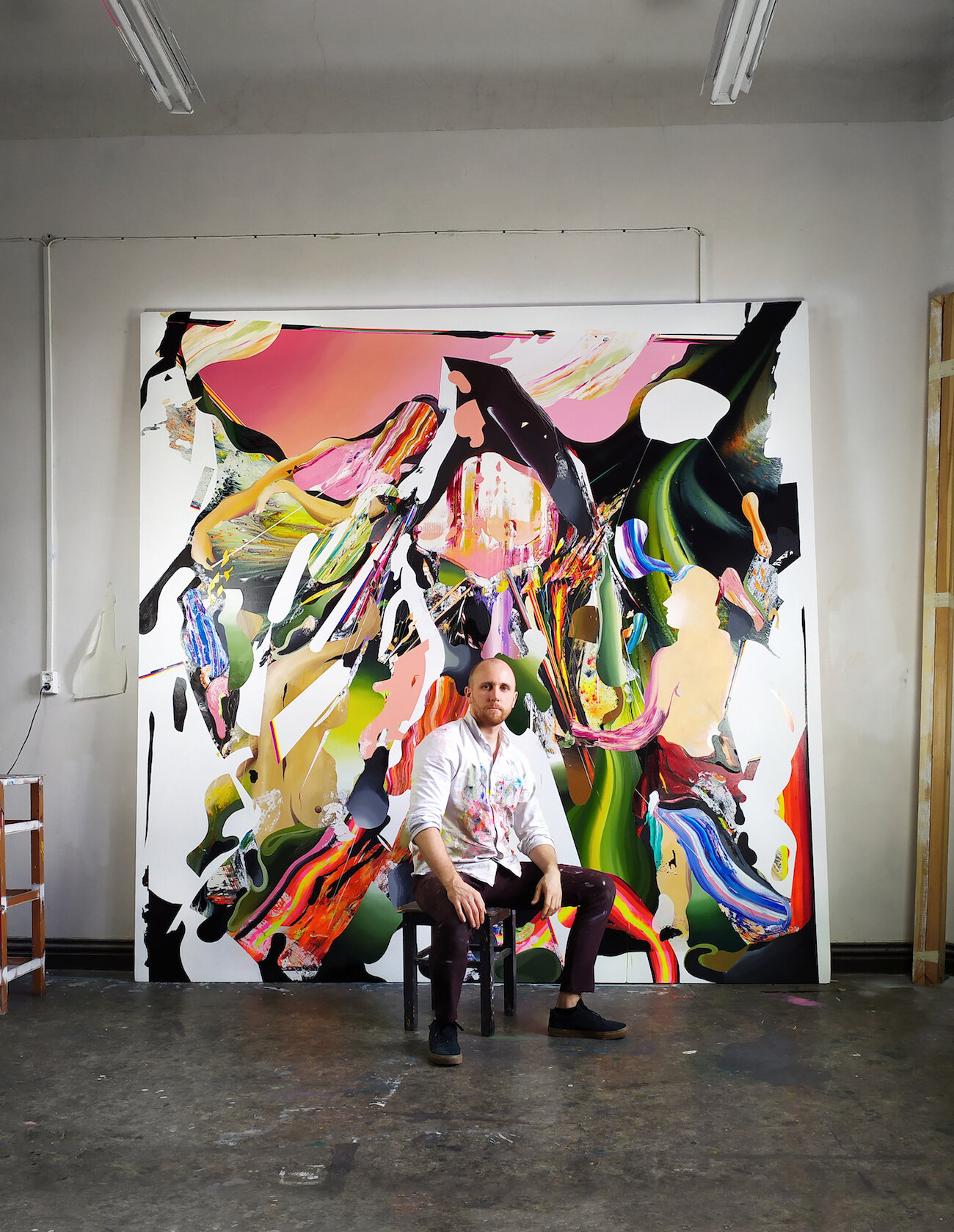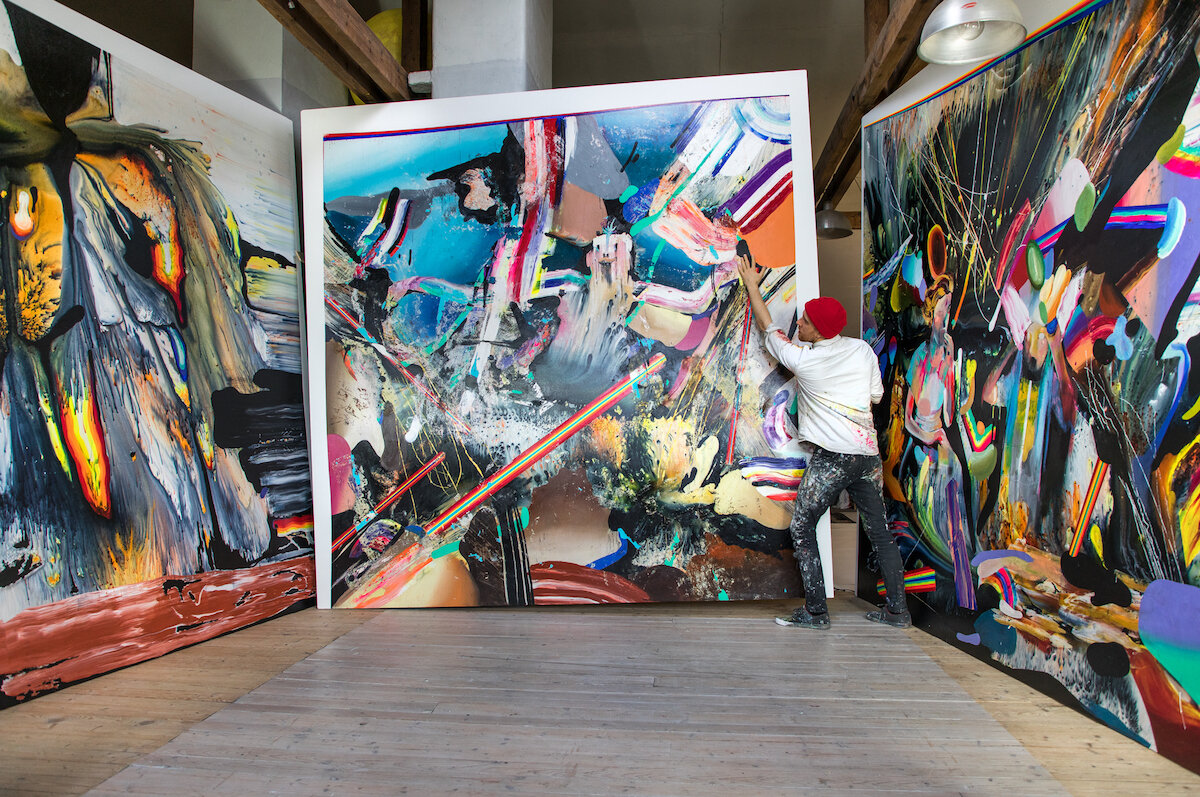Klavs Loris
Klavs Loris’ artistic style can be observed in his large-scale works, where the painter continuously experiments with techniques, combining classical oil painting with more modern mediums and materials. During these experimentations, Klavs Loris has developed his own author-technique, which combines photography, digital print and classical painting.
Philosophy and historical processes, and the available literature generate a big influence on my creative work. The visual and written heritage that is left to us, as well as transmitted values affect me on a personal level. An essential part of the creative process is the text. Keywords and concepts by philosophers and thinkers, and writings from different cultures around the world are as a “backbone” for the paintings, from which the visual side of the work is derived later on.
Could you tell us a little more about your background, and how did you begin creating art?
I remember very vividly that time in my childhood, when the process of creation took over and became everything for me. It was like the Big Bang from which all my future creative activity developed:
I was about 4 years old. The Soviet Union had collapsed, and the country was in chaos. We were a poor family of six and all lived in a one-room apartment. As the situation was gloomy and unenviable, the father, trying to please his children, made miniature houses out of paper - folded, cut, glued and marked them with window panes, doors and tiles. For me it was the greatest miracle and I enthusiastically followed the whole process of creation.
It was these moments of building paper houses, when such an overflow of emotions and great imagination was achieved with such minimal resources. It made some sort of addiction, which held a desire to return and stay in the state of creation for longer.
Years went by and studies at the art school followed, which I graduated as the sculptor, but the art academy I entered as a painter. During my studies, I turned to street art, photography, design and music, but in the end all roads always returned to painting. Right now, I can't imagine my daily life without creative expression.
What does your art aim to say to the viewers?
I know it may sound cliche but inspiring others is a sacred act for me.
Upon finishing the paintings, they don’t have any social, cultural, political or conceptual message; they are a new starting point. From the moment of completion, the artwork is self-sufficient, and all that is left to do is to observe it and reflect upon.
It is important for the viewer to create his own inner narrative, so I rarely talk about my paintings, I do not want to influence the viewer's thoughts. It is better to form an internal dialogue yourself. My goal towards the viewer would be to create any kind of emotions, in their purest form.However, historical processes, and the available literature generate a big influence on my creative work. The visual and written heritage that is left to us, as well as transmitted values affect me on a personal level. Keywords and concepts by thinkers, and writings from different cultures around the world are as “backbone” for the paintings, from which the visual side of the work is derived later on.
Can you tell us about the process of creating your work? What is your daily routine when working?
Painting for me is a continuous process of experimenting and self-awareness. I am fascinated by technical and ideological coincidences taking over and leading my work. I also allow various external factors to affect my works, be them opinions or commentaries, information available, or even the social and political hustle and bustle. This makes me a receiving antenna and my paintings — data projection. As a result, it turns into some kind of a roleplay, where accidents, opinions, and my control over the painting fight for dominance.
Usually I like to work on multiple paintings at once. When working I am continuously experimenting with numerous techniques and materials, like oil, acrylic, floor varnish and carpet glue, glitter powders, and dry pigments from the Soviet-time textile plants. The whole process is more similar to a physical activity or even a ritual dance, as I am constantly moving around large-size canvas, painting with my hands and various objects, strapping the work with a colour-soaked string and polishing it with a polisher, applying tape and varnish-soaked pieces of fabric which I then tear down together with layers of paint, thus revealing rough surface.
What’s the essential element in your art?
It's a combination of many elements - colour, shape, texture, composition, rhythm and movement. It all comes down to project. In terms of materials and thematic, growth is an important element , so I experiment a lot and move the bar higher all the time.
I guess a lot of things are essential. For example, silence in the studio is a crucial element, or before I do any work, I sit for hours and stare at an empty canvas. Sometimes I just walk around the studio and contemplate what I could do. You know, lots of those nonsense artsy things!
In your opinion, what role does the artist have in society?
The job of the artist is to build a bridge between our vast internal world and how little we actually express on a daily basis. The artist may serve as a loudspeaker for society's collective thoughts.
Sometimes the role of the artist is to keep us all in a sweet spot between utterly boring reality and absolute insanity. In a good way!
Website: www.klavsloris.com








